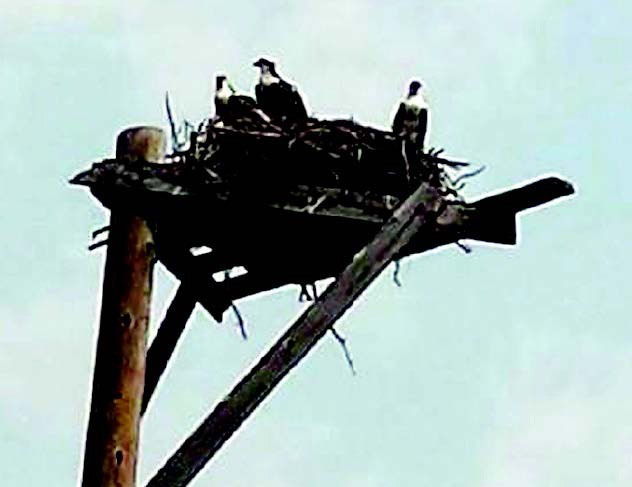A pair of Osprey have been nesting and raising their chicks at Lady Lake for nine years and were captured in a photograph on August 10 by Terry Galandy who resides next to the nesting Osprey.
The osprey, sometimes known as the fish eagle, sea hawk, river hawk, or fish hawk, is a diurnal, fish-eating bird of prey. It is a large raptor, reaching more than 60 cm (24 in.) in length and 180 cm (71 in.) across the wings. The osprey tolerates a wide variety of habitats, nesting in any location near a body of water providing an adequate food supply. It is found on all continents except Antarctica, although in South America it occurs only as a non-breeding migrant, according to the Wikipedia web site.
As its other common names suggest, the osprey’s diet consists almost exclusively of fish. It possesses specialized physical characteristics and exhibits unique behaviour to assist in hunting and catching prey. As a result of these unique characteristics, it has been given its own taxonomic genus, Pandion and family, Pandionidae. Four subspecies are usually recognized, one of which has recently been given full species status. Despite its propensity to nest near water, the osprey is not classed as a sea eagle.
In flight, the osprey has arched wings and drooping “hands,” giving it a gull-like appearance. The call is a series of sharp whistles, described as cheep, cheep or yewk, yewk. If disturbed by activity near the nest, the call is a frenzied cheereek.
Generally, ospreys reach sexual maturity and begin breeding around the age of three to four, though in some regions with high osprey densities, such as Chesapeake Bay in the U.S., they may not start breeding until five to seven years old, and there may be a shortage of suitable tall structures. If there are no nesting sites available, young ospreys may be forced to delay breeding. To ease this problem, posts are sometimes erected to provide more sites suitable for nest building.
Ospreys usually mate for life. The female lays two to four eggs within a month, and relies on the size of the nest to conserve heat. The eggs are whitish with bold splotches of reddish-brown and are about 6.2 cm by 4.5 cm (2.4 in by 1.8 in) and weigh about 65 g (2.3 oz). The eggs are incubated for about fi ve weeks to hatching. The newly hatched chicks weigh only 50–60 g (1.8–2.1 oz), but fl edge in 8–10 weeks. The typical lifespan is 7–10 years, though rarely individuals can grow to as old as 20–25 years.




